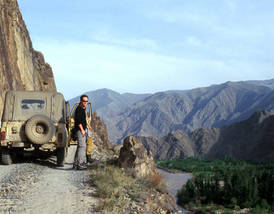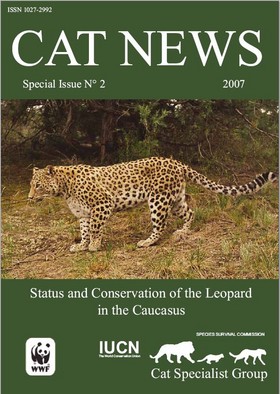Foreword

- © F. Mörschel

- © F. Mörschel
Cat News Special Issue No. 2, jointly produced by WWF and the IUCN/SSC Cat Specialist Group, is dedicated to the memory of
Heinz W. Stalder
1955-2005
Heinz got his doctoral degree from the University of Bern, Switzerland in 1988 for his thesis on red fox ecology in the Alps. On 1 April 1988, Heinz joined WWF Switzerland and became project coordinator. He played an important role in the leopard conservation project in the Caucasus. In spring 2005, when Victor Lukarevsky visited Switzerland, we sat all together and made plans on how to save the mighty cat in the Caucasus. Two month later, Heinz died unexpectedly.
We are badly missing Heinz’ constructive sarcasm in our discussions, but the show must go on. This special issue of Cat News, summarising our present knowledge on the leopard in the Caucasus, is another step on a path that was decisively traced out by Heinz. It will be a narrow and a rough road, like those crossing the mountains in the Caucasus, and we will encounter many obstacles to be removed. Nevertheless, if we know our common goal and work all together to reach it, we will succeed.
Urs and Christine Breitenmoser
Conservation of the Leopard in the Caucasus by N. Zazanashvili, F. Mörschel, E. Askerov, K. Manvelyan, V. Krever, M. T. Farvar and S. Kalem
This report attempts to compile and analyze all existing data on leopards and their conservation in the Caucasus creating a sound basis for the development of a leopard conservation strategy for the entire region. The Caucasus spans 6 countries and has been recognized as globally outstanding for its biodiversity. The leopard was identified as top priority species by the Ecoregional Conservation Plan (ECP), a key strategic document for biodiversity conservation in the region. Information on leopards before year 2000 has mainly been based on indirect evidences (tracks, skins). No scientific research or direct conservation action has been carried out during that time. Despite the fact that leopards indirectly benefited from the establishment of protected areas, they have been directly persecuted. As a result, their numbers have been dramatically reduced. Beginning in 2001, WWF has started to systematically investigate the status of leopards in the Caucasus through surveys and field monitoring. Additionally, urgent conservation measures have been implemented. This work not only improved the situation for the leopard but also managed to shift public opinion and perception. The leopard has become a symbol for the need of cooperation among the Caucasus countries because this wide-ranging cat can not be saved by one country alone.
Biology and Ecology of the Leopard in the Caucasus by V. Lukarevsky, A. Malkhasyan and E. Askerov
The Caucasus leopard is large, weighing up to 60 kg, and light in colour. The taxonomy has been confused, with at least three named forms reportedly occurring in the area. It is now considered that all leopards occurring in the Caucasus, northern Iran and Turkmenistan, are a single form, referred to here as Panthera pardus saxicolor. Very little field research has been conducted on the biology and ecology of leopards in the Caucasus. Estimates of abundance range from 0.4 individuals/100km2 based on scat analyses to 1 per 100 km2. Anecdotal reports indicate that one male overlaps the ranges of 2–3 females. Leopards in the Caucasus often move along mountain ridges that offer a wide view of the surrounding area and frequently make use of established paths. A dietary study based on scat analysis showed that wild boar formed the main prey in south Armenia. Wild ungulates are generally considered to constitute the main prey, along with smaller mammals such as hares and porcupines and game birds. Habitat consists of subalpine meadows, broadleaved forests and rugged ravines from 600–3,800m in the Greater Caucasus and rocky slopes, mountain steppes, and sparse juniper forests in the Lesser Caucasus and Iran.
Status of the Leopard in the Caucasus by V. Lukarevsky, M. Akkiev, E. Askerov, A. Agili, E. Can, Z. Gurielidze, A. Kudaktin, A. Malkhasyan and Y. Yarovenko
There has been a huge decline in the former range of the leopard in the Caucasus, which is estimated to have once covered the whole region, except for steppe areas. More recent surveys, including those conducted by WWF since 2001 and others, based on searches for field signs, camera trapping and questionnaires have clarified the situation to some degree. These surveys have confirmed some surviving nuclei and identified possible sites and promising areas for further survey. The largest populations in the ecoregion survive in Iran, which seems to be a stronghold for the leopard in the region. The current presence of leopards in NE Turkey is not confirmed. Leopards have disappeared from the western part of the Greater Caucasus and are known from very few localities in the east. A few occurrences are known in the Lesser Caucasus, including Khosrov reserve and the mountain ridges along the border between south Armenia and Azerbaijan. Existing sites are fragmented and estimated numbers are very low, even down to a single animal in one case. Tentative estimates indicate not more than 15 leopards in the Greater Caucasus and up to 50 in the Lesser Caucasus and Iran. The viability of these small remnants, and the extent to which they are dependent on immigration from Iran is not known.
Status of the Prey Species of the Leopard in the Caucasus by D. Mallon, P. Weinberg and N. Kopaliani
The severe economic crisis that followed major political and social changes in 1992 in the former Soviet Union, together with a weakening of formerly effective protection systems resulted in a sharp rise in hunting of wild ungulates and exploitation of natural resources. As a consequence, turs, bezoar goat, wild sheep, chamois, red deer and roe deer have all declined in abundance over the past 15 years, their ranges have been reduced and in many cases are becoming fragmented. In Iran, the decline in ungulate numbers has taken place over a longer timescale, since 1978. The only ungulate species in the ecoregion that has been relatively unaffected is wild boar. The effects on smaller mammalian prey such as porcupines and hares are unknown. The precise extent of species declines is difficult to evaluate in many cases because of inadequacies in baseline data and lack of monitoring programmes. The best populations of ungulates survive in a few protected areas such as the Kavkasky, Khosrov, Kazbegi and Zakataly Reserves and remote areas of Dagestan. The extent to which fragmented and depleted prey populations at an ecoregion-wide scale can support viable leopard populations, and over what time scale, needs urgently to be assessed.
Mapping the Vision – Potential Living Space for the Leopard in the Caucasus by F. Zimmermann, V. S. Lukarevsky, G. Beruchashvili, Ch. Breitenmoser-Würsten and U. Breitenmoser
The present distribution of leopard (P. p. saxicolar) in the Caucasus is restricted to several small nuclei. 100 confirmed leopard observations since 1990 have been used to model the potential distribution of the species in the ecoregion by means of an Ecological Niche Factor Analysis, to assess habitat suitability and patchiness. Variables predicting leopard distribution were terrain ruggedness, distance to highways, and slope, reflecting the inaccessibility of a given area. Best fit was achieved using the harmonic mean algorithm, which produces a rather restrictive model. A total of 123,850 km² were identified as suitable habitat, separated into many patches, of which 12 were >1,000 km². A potential Caucasus meta-population could probably host up to 1,200 leopards. Large continuous clusters are located in NE Turkey, Armenia and west Azerbaijan, and in the eastern part of the Greater Caucasus. Habitat patches in the centre of the Lesser and the west of the Greater Caucasus are smaller and more fragmented. Given the limited input data, the model is relatively coarse, but it allows identifying priority areas for further field surveys and reveals critical areas for the maintenance of habitat corridors for the recolonisation of now empty patches.
General Conditions for the Conservation of the Leopard in the Caucasus by by U. Breitenmoser, Ch. Breitenmoser-Würsten, F. Mörschel, N. Zazanashvili and M. Sylvén
For the conservation of the leopard, a highly endangered flagship species of the Caucasus ecosystem, a close cooperation between governmental agencies, non-governmental organisations and scientists on national and international level is needed. The programme implies not only protection of the leopard, but also preserving its habitat and wild prey, and working with various stakeholders from the international level down to local people. Such a complex programme requires well-designed communication and planning. The first step is to compile all available information in a status report to assess the present situation. Then, a range-wide conservation strategy needs to be developed in a participatory process involving all relevant organisations from the range states and international partners. This strategy defines the common goals and provides a framework for the planning of conservation activities in each country. The third step will be the development of national action plans, allowing the involvement of stakeholders and local people and the assignment of concrete tasks to the designated actors.


